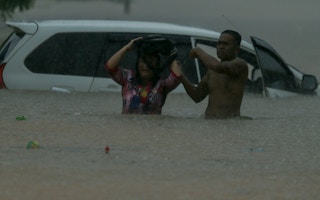Climate change is bringing with it more frequent storms, floods, wildfires and other costly risks, which is in turn making homeowner’s insurance increasingly either unaffordable or unavailable in growing parts of the United States.
State Farm, the largest home insurer in the United States in 2022, announced last week it would not accept new applications for homeowners policies in wildfire-ravaged California, a change that has sent shockwaves through insurance markets.
Here is how stronger climate change impacts could drive a potential “end of insurance” in the United States:
What does State Farm’s decision mean for access to insurance?
State Farm cited “rapidly growing catastrophe exposure” as among the reasons it will stop accepting new applications in California – a move that could be a harbinger for other insurers’ willingness to write policies in increasingly risky areas.
The company’s decision follows damaging fire seasons in 2017 and 2018 that led other insurance firms to not renew policies in high-risk areas – a trend California has tried to slow with moratoriums on non-renewals.
State Farm’s move “is an indication that insurers didn’t view 2017 and 2018 as sort of one-off, terrible-loss years but as a trend of ever-increasing risk,” said Carolyn Kousky of Environmental Defense Fund (EDF), a nonprofit group.
The 2017-18 fire seasons in California cost home insurers more than US$20 billion in underwriting losses, helping wipe out almost double the previous 26 years of profit, according to research from Milliman, an actuarial and consulting firm.
Why is climate change driving up prices for home insurance?
Climate change is bringing with it harsher and more frequent disasters from floods to fires, making it increasingly difficult for risk-averse insurance companies to model anticipated claims and losses, and to pay for them.
Compared to car insurance, for example, disaster insurance is more difficult to price when quiet years can swiftly give way to a crush of claims.
“They have to be able to pay those claims without going bankrupt,” Kousky said.
Buying reinsurance - essentially insurance for insurance companies – can help but the costs are ultimately passed on to homeowners.
Beyond climate-related factors, inflation has also increased insurance claim costs, said Mark Sektnan, vice president for state government relations for the American Property Casualty Insurance Association (APCIA), a trade group.
With homes continuing to be built in risky areas - from dry forests to floodplains - human choices are also a factor in rising insurance costs.
In places like flood-prone Florida, “we keep building more and more expensive buildings in harm’s way,” said Daniel Osgood of the Columbia Climate School’s International Research Institute for Climate and Society.
Effectively, we are making a “human choice to make a less-resilient future”.
How much are insurance prices rising?
While costs vary by state, the average US home insurance premium has increased from US$979 in 2011 to US$1,544 in 2022, according to the Insurance Information Institute, an industry research group.
But states facing particularly high risks are seeing larger increases.
In California, one large condominium complex outside of San Diego saw their US$47,000-a-year policy dropped last year as a result of increasing fire risk - and one quote they found for a replacement was priced at US$600,000.
The average annual cost of flood insurance through the federal government’s National Flood Insurance Program similarly is expected to roughly double in the coming years for single-family homes, from US$888 to US$1,808.
The projections apply to policies that came onto a new risk rating system, intended in part to account for worsening climate change risks, as of September.
Will insurance still be available as climate change impacts strengthen?
A number of insurance companies have simply left particularly climate-vulnerable states like Florida and Louisiana in the face of growing losses.
That has forced many homeowners to pursue costly alternative coverage through state-backed insurers of last resort.
“This is starting to happen in various parts of the country, whether it’s from flood risk or hurricane risk - or from fire risk in the case of State Farm’s announcement,” said Rob Moore with the Natural Resources Defense Council (NRDC), a nonprofit.
State Farm’s move is very likely a preview of more insurance changes to come, including insurers deciding to curtail their business based on risks in particular geographies, Moore said.
“It’s tempting to say, ‘Oh, insurers are a bad guy for not wanting to stay and insure people’s properties,’” he said. “But they’re a business.”
This story was published with permission from Thomson Reuters Foundation, the charitable arm of Thomson Reuters, that covers humanitarian news, climate change, resilience, women’s rights, trafficking and property rights. Visit https://www.context.news/.

















